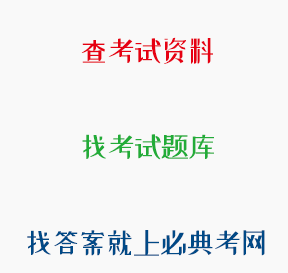正确答案: C
States’ legitimate role in immigration enforcement.
题目:On which of the following did the Justices agree,according to Paragraph4?
解析:考点分析:此题考查考生对文章细节信息的把握能力选项分析:根据题干的关键词the Justice 和Paragraph 4, 就可以准确定位在第四段。因为是判断正误题,我们就可以采用排除的方法。通过观察选项,发现B.C都是围绕State, 我们就可以先找关于它的内容。第四段第二句话提到,议会通常想象联邦和州一起实施移民法律,而且明确鼓励州和联邦的官员共享信息以及合作。所以C选项,即州在移民实施方面的合法的作用,是正确答案。
学习资料的答案和解析:
“坚持四项基本原则’’回答了解放和发展生产力的政治保证问题,体现了社会主义基本制度的要求
“一个中心、两个基本点,,是一个整体,揭示了中国特色往会主义的客观规律和发展道路
一事物区别于它事物就在于矛盾的特殊性
人的认识是在实践中不断的深化和发展的
根据以下资料,回答下面的题目。In the 2006 film version of The Devil Wears Prada, Miranda Priestly, played by Meryl Streep, scold her unattractive assistant for imagining that high fashion doesn’t affect her.Priestly explains how the deep blue color of the assistant’s sweater descended over the years from fashion shows to department stores and to the bargain bin in which the poor girl doubtless found her garment.This top-down conception of the fashion business couldn’t be more out of date or at odds with feverish world described in Overdressed, Elizabeth Cline’s three-year indictment of “fast fashion”.In the last decades or so, advances in technology have allowed mass-market labels such as Zara, H&M, and Uniqlo to react to trends more quickly and anticipate demand more precisely.Quckier turnrounds mean less wasted inventory, more frequent releases, and more profit.Those labels encourage style-conscious consumers to see clothes as disposal—— meant to last only a wash or two, although they don’t advertise that——and to renew their wardrobe every few weeks.By offering on-trend items at dirt-cheap prices, Cline argues, these brands have hijacked fashion cycles, shaking all industry long accustomed to a seasonal pace.The victims of this revolution, of course, are not limited to designers.For H&M to offer a 5.95 knit miniskirt in all its 2300-plus stores around the world, it must rely on low-wage, overseas labor, order in volumes that strain natural resources, and use massive amount of harmful chemicals.Overdressed is the fashion world’s answer to consumer activist bestsellers like Michael Pollan’s The Omnivore’s Dilemma.Mass-produced clothing, like fast food, fills a hunger and need, yet is non-durable, and wasteful,” Cline argues, Americans, she finds, buy roughly 20 billion garments a year——about 64 items per person——and no matter how much they give away, this excess leads to waste.Towards the end of Overdressed, Cline introduced her ideal, a Brooklyn woman named SKB, who, since 2008 has make all of her own clothes——and beautifully.But as Cline is the first to note, it took Beaumont decades to perfect her craft; her example, can’t be knocked off.Though several fast-fashion companies have made efforts to curb their impact on labor and the environment——including H&M, with its green Conscious Collection Line——Cline believes lasting-change can only be effected by the customer.She exhibits the idealism common to many advocates of sustainability, be it in food or in energy.Vanity is a constant; people will only start shopping more sustainably when they can’t afford to it.Priestly criticizes her assistant for her
shut out the feverish fashion world.
根据以下资料,回答下面的题目。In the 2006 film version of The Devil Wears Prada, Miranda Priestly, played by Meryl Streep, scold her unattractive assistant for imagining that high fashion doesn’t affect her.Priestly explains how the deep blue color of the assistant’s sweater descended over the years from fashion shows to department stores and to the bargain bin in which the poor girl doubtless found her garment.This top-down conception of the fashion business couldn’t be more out of date or at odds with feverish world described in Overdressed, Elizabeth Cline’s three-year indictment of “fast fashion”.In the last decades or so, advances in technology have allowed mass-market labels such as Zara, H&M, and Uniqlo to react to trends more quickly and anticipate demand more precisely.Quckier turnrounds mean less wasted inventory, more frequent releases, and more profit.Those labels encourage style-conscious consumers to see clothes as disposal—— meant to last only a wash or two, although they don’t advertise that——and to renew their wardrobe every few weeks.By offering on-trend items at dirt-cheap prices, Cline argues, these brands have hijacked fashion cycles, shaking all industry long accustomed to a seasonal pace.The victims of this revolution, of course, are not limited to designers.For H&M to offer a 5.95 knit miniskirt in all its 2300-plus stores around the world, it must rely on low-wage, overseas labor, order in volumes that strain natural resources, and use massive amount of harmful chemicals.Overdressed is the fashion world’s answer to consumer activist bestsellers like Michael Pollan’s The Omnivore’s Dilemma.Mass-produced clothing, like fast food, fills a hunger and need, yet is non-durable, and wasteful,” Cline argues, Americans, she finds, buy roughly 20 billion garments a year——about 64 items per person——and no matter how much they give away, this excess leads to waste.Towards the end of Overdressed, Cline introduced her ideal, a Brooklyn woman named SKB, who, since 2008 has make all of her own clothes——and beautifully.But as Cline is the first to note, it took Beaumont decades to perfect her craft; her example, can’t be knocked off.Though several fast-fashion companies have made efforts to curb their impact on labor and the environment——including H&M, with its green Conscious Collection Line——Cline believes lasting-change can only be effected by the customer.She exhibits the idealism common to many advocates of sustainability, be it in food or in energy.Vanity is a constant; people will only start shopping more sustainably when they can’t afford to it.Priestly criticizes her assistant for her

 川公网安备 51012202001360号
川公网安备 51012202001360号